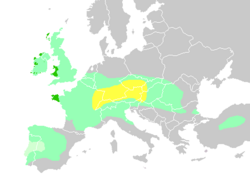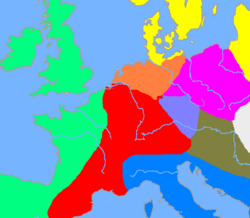History:Pre-Celtic Europe

Pre-Celtic Europe is the period of the prehistory of Europe before the emergence and spread of the Celtic peoples.
History
When the Celts were first recorded about 600 BC, they were already widespread across Iberia, Gaul, and Central Europe.[citation needed] In Ireland, the Book of Invasions gives a legendary account of the arrival of incoming peoples.
Languages
Proto-Celtic is mainly dated to approximately 800 BC, coincident with the Hallstatt culture, while the earliest possible divergence of pre-proto-Celtic dialects from Proto-Indo-European is mainly dated to between 3000 BC and 2000 BC.
In continental Europe, pre-Celtic languages of the European Bronze Age may be taken to comprise two distinct groups.
- Non-Indo-European languages (i.e. pre-Indo-European languages); these include Aquitanian (precursor of the Basque),[1][2] Rhaetic, Etruscan,[3] Iberian, which might be related to Basque but is still unclassified, and Paleo-Sardinian (there is evidence suggesting that it had connection to the reconstructed Proto-Basque and to the Iberian language). Some scholars group Etruscan, Rhaetic and Lemnian together in the hypothetical Tyrrhenian language family, which possibly originated in the Aegean Sea region or during the Neolithic north of the Alps.[4][5][6][7] Conversely, the Lemnian language could have arrived in the Aegean Sea during the Late Bronze Age, when Mycenaean rulers recruited groups of mercenaries from Sicily, Sardinia and various parts of the Italian peninsula.[8]
- Indo-European dialects, such as Illyrian, possibly Lusitanian, the Proto-Italo-Celtic dialects, Belgian and "Old European".[9] However, Lusitanian and Belgian may turn out to be Celtic, while Old European may turn out to be either Celtic or non-Indo-European. The very existence of Indo-European speakers in Western Europe before the arrival of the Celts is highly speculative.
It has been suggested that results of large-scale genetic surveys, undertaken since the late 20th century, show that the present-day speakers of pre-Indo-European languages might not solely represent relict populations. For instance, Basques show a dominance of the Y-DNA Haplogroup R1b,[10] which a majority of scholars now propose spread through Europe relatively recently, from the Eurasian steppe and/or southwest Asia in the late Neolithic period or early Bronze Age (4,000 to 8,000 years ago).[11][10][12][13][14][15] R1b replaced nearly all indigenous male lineages in Iberia from 2500 to 2000 BC.[16] However, present-day Basques also retain some very rare and archaic lineages, such as the Paleolithic mitochondrial DNA Haplogroup U8a, and autosomal genetic analysis (the whole genome, not just Y-DNA) has shown that a majority of their ancestry derives from Neolithic farmers and Mesolithic hunter-gatherers, predating the arrival of speakers of Indo-European languages.[11][17][18][19]
Archaeology
See also
- Neolithic Europe
- Old European culture
- Bronze Age Europe
- Old European hydronymy
- Pre-Germanic
- Vasconic substratum hypothesis
- Atlantic (Semitic) languages
- Pre-Roman peoples of the Iberian Peninsula
- Prehistoric Britain
- Bronze Age Britain
- Prehistoric Ireland
- Paleolithic continuity theory
- Italo-Celtic
- Goidelic substrate hypothesis
- Magdalenian
References
- ↑ Trask, R. L. (1997). The History of Basque. p. 9.Citing Bertranpetit and Cavalli-Sforza: "Basques represent descendants of Paleolithic and/or Mesolithic populations and non-Basques later arrivals, beginning with the Neolithic."
- ↑ Hualde, José Ignacio; Ortiz de Urbina, Jon (2003). A Grammar of Basque. p. 7.
- ↑ Pallottino (1955). p. 52. "[The Etruscans]...an ethnic island of very ancient peoples isolated by the flood of Indo-European speakers."
- ↑ Facchetti, Giulio M.; Negri, Mario (2003). Olschki, Leo S.. ed. "Creta Minoica: Sulle tracce delle più antiche scritture d'Europa". Biblioteca dell'Archivum Romanicum. Serie II: Linguistica 55. ISBN 8822252918.
- ↑ Bonfante, Larissa (1990). Etruscan. Berkeley and Los Angeles: University of California Press. ISBN 978-0-520-07118-6.
- ↑ De Simone, Carlo (2009). "La nuova iscrizione tirsenica di Efestia". Tripodes 11: pp. 3–58.
- ↑ Steinbauer, Dieter H. (1999). Neues Handbuch des Etruskischen. St. Katharinen: Scripta Mercaturae Verlag.
- ↑ De Ligt, Luuk (2008–2009). "An 'Eteocretan' Inscription from Praisos and The Homeland of The Sea Peoples". Talanta 40–41: 151–172. http://www.talanta.nl/wp-content/uploads/2014/08/TAL-40-412008-2009-pag-151-172-DeLigt.pdf.
- ↑ Kitson, P.R. (November 1996). "British and European River Names". Transactions of the Philological Society 94 (2): 73–118. doi:10.1111/j.1467-968X.1996.tb01178.x.
- ↑ 10.0 10.1 Balaresque, Patricia; Bowden, Georgina R.; Adams, Susan M.; Leung, Ho-Yee; King, Turi E.; Rosser, Zoë H.; Goodwin, Jane; Moisan, Jean-Paul et al. (2010). Penny, David. ed. "A Predominantly Neolithic Origin for European Paternal Lineages". PLOS Biology (Public Library of Science) 8 (1): e1000285. doi:10.1371/journal.pbio.1000285. PMID 20087410.
- ↑ 11.0 11.1 Haak, Wolfgang; Lazaridis, Iosif; Patterson, Nick; Rohland, Nadin; Mallick, Swapan; Llamas, Bastien; Brandt, Guido; Nordenfelt, Susanne et al. (2015). "Massive migration from the steppe is a source for Indo-European languages in Europe". Nature 522 (7555): 207–11. doi:10.1038/NATURE14317. PMID 25731166. PMC 5048219. Bibcode: 2015Natur.522..207H. http://biorxiv.org/content/early/2015/02/10/013433.
- ↑ "Y-DNA Haplogroup R and its Subclades". International Society of Genetic Genealogy. http://www.isogg.org/tree/ISOGG_HapgrpR.html.
- ↑ Arredi, B.; Poloni, E. S.; Tyler-Smith, C. (2007). "The Peopling of Europe". in Crawford, M.. Anthropological Genetics: Theory, Methods and Applications. Cambridge University Press.[page needed]
- ↑ Myres, Natalie; Rootsi, Siiri; Lin, Alice A; Järve, Mari; King, Roy J.; Kutuev, Ildus; Cabrera, Vicente M; Khusnutdinova, Elza K et al. (2010). "A major Y-chromosome haplogroup R1b Holocene effect in Central and Western Europe". European Journal of Human Genetics 19 (1): 95–101. doi:10.1038/ejhg.2010.146. PMID 20736979.
- ↑ Sjödin, Per; François, Olivier (2011). Lalueza-Fox, Carles. ed. "Wave-of-Advance Models of the Diffusion of the Y Chromosome Haplogroup R1b1b2 in Europe". PLOS ONE 6 (6:e21592): e21592. doi:10.1371/journal.pone.0021592. PMID 21720564. Bibcode: 2011PLoSO...621592S.
- ↑ McIntosh, Bennett (2019). "Replacement of Iberian Men 4,000 Years Ago Raises Fresh Questions". Harvard Magazine. https://harvardmagazine.com/iberia-men-19.
- ↑ Allentoft, Morten E.; Sikora, Martin; Sjögren, Karl-Göran; Rasmussen, Simon; Rasmussen, Morten; Stenderup, Jesper; Damgaard, Peter B.; Schroeder, Hannes et al. (2015). "Population genomics of Bronze Age Eurasia". Nature 522 (7555): 167–172. doi:10.1038/nature14507. PMID 26062507. Bibcode: 2015Natur.522..167A. https://depot.ceon.pl/handle/123456789/13155.
- ↑ Mathieson, Iain; Lazaridis, Iosif; Rohland, Nadin; Mallick, Swapan; Patterson, Nick; Alpaslan Roodenberg, Songul; Harney, Eadaoin; Stewardson, Kristin et al. (2015). "Eight thousand years of natural selection in Europe". bioRxiv: 016477. doi:10.1101/016477. http://biorxiv.org/content/early/2015/03/13/016477.
- ↑ González, A. M.; García, O.; Larruga, J. M.; Cabrera, V. M. (2006). "The mitochondrial lineage U8a reveals a Paleolithic settlement in the Basque country". BMC Genomics 7: 124. doi:10.1186/1471-2164-7-124. PMID 16719915.
Bibliography
- Thompson, T. (2006). Ireland's Pre-Celtic Archaeological and Anthropological Heritage. Lewiston, New York: Edwin Mellen Press.
- Waddell, J. (1991). "The Celticization of the West: an Irish Perspective". in Chevillot, C.; Coffyn, A.. L'Age du Bronze Atlantique: Actes du 1er Colloque de Beynac. Beynac. pp. 349–366.
- Waddell, J. (1991). "The Question of the Celticization of Ireland". Emania 9: 5–16.
- Waddell, J. (April 1995). "Celts, Celticisation and the Irish Bronze Age". in Waddell, J.; Shee Twohig, E.. Ireland in the Bronze Age: Proceedings of the Dublin Conference. pp. 158–169.
 |


